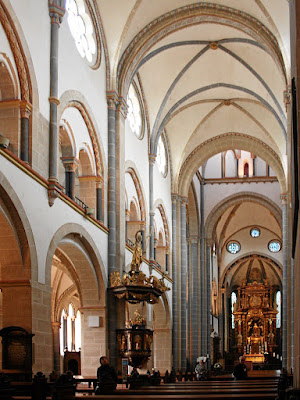Basilicas in Germany—North Rhine-Westphalia
Basilica of St. Mary Comforter of the Sadnesses, Kevelaer
Declared a minor basilica by Pope Pius XI in 1923.
The Neo-Gothic church was built in the mid-19th Century. The church is a Marian pilgrimage site and has the largest German-Romanic pipe organ in the world.
All pictures are from Wikipedia.
Basilica of St. Victor, Xanten
Declared a minor basilica by Pope Pius XI in 1936.
The Gothic Basilica was built between 1263 and 1544. It is named for a 4th Century Roman soldier who was martyred for the Faith.
All pictures are from Wikipedia except the first which is from a local source.
Basilica of the Visitation of the Virgin Mary, Werl
Declared a minor basilica by Pope Pius XII in 1953.
A wooden 12th Century Madonna was brought to a Capuchin convent in 1661 and pilgrimages to the church began and continue. A new Baroque church was built between 1786 and 1789. By the beginning of the 20th Century, the Franciscans, who were now in charge of the church, built the current Neo-Romanesque church between 1904 and 1906 next to the old church.
Both pictures are from Wikipedia.
Basilica of Sts. Potentinus, Felicius and Simplicius, Kall-Steinfeld
Declared a minor basilica by Pope John XXIII in 1960.
A monastery was built at this site in the 10th Century, and it became a monastery for the Premonstratensian Order in 1130. The abbey was secularized in 1820 and the abbey church became a parish church. The Salvatorian Order reestablished the monastery in 1923. The abbey church dates to the 12th Century and was originally Romanesque, but Gothic, Renaissance, and Baroque elements have been added. The pipe organ dates to 1600.
All pictures are from Wikipedia.
Basilica of St. Suitbert, Dusseldorf
Declared a minor basilica by Pope Paul VI in 1967.
The church is on the site of an 8th Century monastery. The church was built of tufa stone in the 11th Century. Originally Romanesque, Gothic elements were added in the 13th Century. The church was enlarged and renovated in the 19th Century. The church’s two towers were destroyed in the Second World War and have not been rebuilt. St. Suitbert, who was English, was a missionary bishop in this area in the 8th Century. He is buried in the Basilica.
Both pictures are from Wikipedia.
Basilica of St. Vitus, Monchengladbach
Declared a minor basilica by Pope Paul VI in 1973.
The Archbishop of Cologne established a Benedictine abbey in 974 and built an abbey church. The church was renovated and enlarged many times over the years. The abbey was closed in 1802 and the church became a parish church. The Gothic church was badly damaged during the Second World War but has been restored. Among the Basilica’s treasures are a 12th Century baptismal font, a 13th Century ivory box, and a church bell dating to 1693. Three older bells were destroyed during the War.
All pictures are from Wikipedia.
Basilica of St. Lambert, Dusseldorf
Declared a minor basilica by Pope Paul VI in 1974.
The brick church dates to 1206 but it was expanded between 1288 and 1394. Its style changed from Romanesque to Gothic. One of its noted features is a twisted spire, probably caused by using damp wood. St. Lambertus was an 8th Century martyr.
All pictures are from Wikipedia.
Basilica of St. Margaret, Dusseldorf-Gerresheim
Declared a minor basilica by Pope John Paul II in 1982.
A women’s monastery was established here in the 9th Century and the current church was built for the monastery between 1220 and 1230 in a Rhenish transitional style. The monastery was closed in 1803. The Basilica contains a blood relic believed to be earth from Golgotha mixed with the Blood of Christ. It also contains a crucifix dating to around 960 and is considered the oldest monumental sculpture in Germany.
All pictures from Wikipedia.
Basilica of St. Ludger, Essen-Werden
Declared a minor basilica by Pope John Paul II in 1993.
The church was built by St. Ludger, a local bishop, in the 9th Century for a Benedictine monastery. Originally Romanesque, a 13th Century redesign added Gothic flavors. Baroque features were added in the 18th Century. The monastery closed in the early 1800s. The church has several works of art including a pyxis that dates to around 500 A.D. that depicts the birth of Jesus—the oldest existing depiction of Jesus’ birth in the world.
The first picture is from a local source and the other two are from Wikipedia.
Minster-Basilica of St. Quirinus of Neuss, Neuss
Declared a minor basilica by Pope Benedict XVI in 2009.
The Rhenish traditional style church was built between 1209 and 1230 and honors the city’s patron saint. The church was built as an abbey church for a monastery established at least by the 12th Century. The monastery did not survive the French Revolution and the church was damaged in both World wars. Restoration work continues.
All pictures are from Wikipedia.
Basilica of St. Ida of Herzfeld, Lippetal-Herzfeld
Declared a minor basilica by Pope Benedict XVI in 2011.
Ida, a Frankish countess, built a church on this site in 790. Pilgrimages began after her canonization in 980. The current neo-Gothic Basilica was built between 1900 and 1903. The church has 15th Century paintings and a 16th Century baptismal font.
All pictures are from Wikipedia.
Basilica of St. Lawrence, Wuppertal
Declared a minor basilica by Pope Francis in 2013.
The classicist style church was built between 1828 and 1835 of pink sandstone.
The first picture is from a local source and the other two are from Wikipedia.














































No comments:
Post a Comment